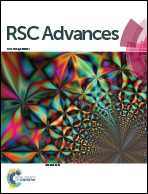A profluorescent nitroxide probe for ascorbic acid detection and its application to quantitative analysis of diabetic rat plasma†
Abstract
15-((9-(Ethylimino)-10-methyl-9Hbenzo[a]phenoxazin-5-yl)amino)-3,11-dioxa-7-azadispiro[5.1.58.36]hexadecan-7-yloxyl, (Nile-DiPy) has been synthesized and examined as an off–on profluorescent nitroxide probe for measuring ascorbic acid in plasma. The substituents around the N–O moiety of nitroxide were used to increase the reactivity and selectivity toward the detection of ascorbic acid. We also investigated the photochemical reaction between the fluorophore and the nitroxide radical, and the reactivity of the Nile-DiPy toward the biological reductant. The fluorescence quenching mechanism of Nile-DiPy was proven to be via electron transfer from the nitroxide radical to the fluorophore moiety, which has been investigated by optical, electrochemical and femtosecond laser-induced transient absorption spectroscopy experiments. Furthermore, the kinetic isotope effect (KIE) for the detection of ascorbic acid was determined to be 9.77, indicating that Nile-DiPy reacts with ascorbic acid to produce the fluorescent Nile-DiPy-H via hydrogen atom transfer. The limit of detection (LOD) of this fluorometric method was estimated to be 9.72 nM, which is the lowest LOD in the detection method using fluorescent nitroxide probe. Additionally, the calculated bond dissociation free energy of ascorbic acid is the lowest among typical biological reductants used in this study. Thus, the reaction between the nitroxide radical and ascorbic acid is thermodynamically feasible to occur. Finally, we confirmed that Nile-DiPy could be used to measure the levels of ascorbic acid in the plasma of healthy and streptozotocin-induced diabetic rats within 20 min. This agreed well with the results from HPLC analysis. Nile-DiPy should be a useful tool for detecting ascorbic acid for biological applications because of its convenience and sensitivity.


 Please wait while we load your content...
Please wait while we load your content...